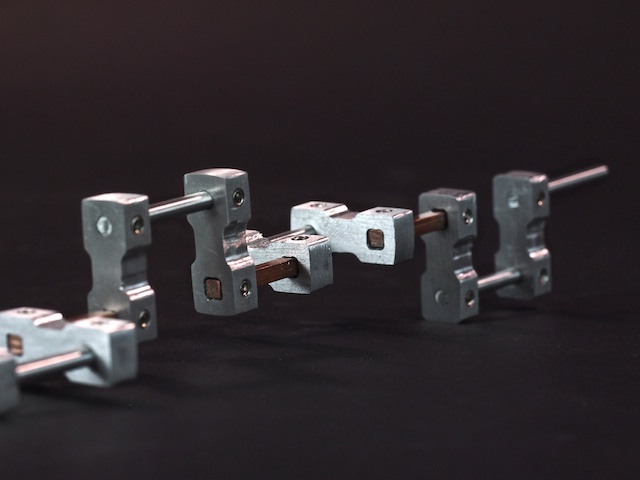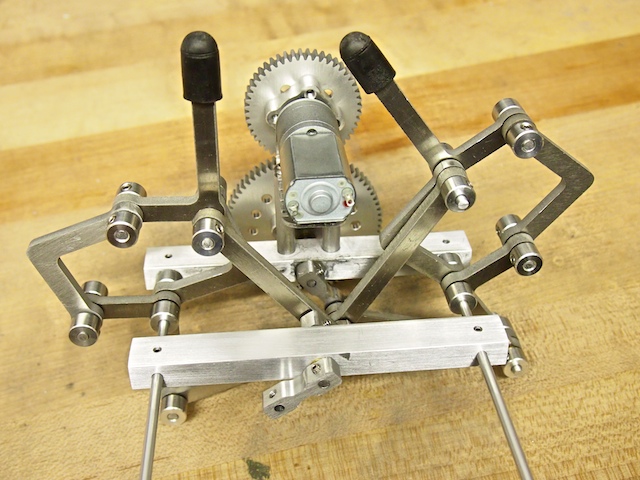We are happy to announce the birth of our latest creation, Aluminalis, a sixteen-legged walking creature. Along with her sixteen legs and feet, Aluminalis has a fast and lively brain (an Arduino Nano), strong muscles (gear motors), elegant bones (custom machined aluminum linkages), two multi-segmented spines (custom designed crankshafts), ears (Xbee Radio), forward and rear sight (ultrasonic sensors), and a voice (tone buzzer). If you communicate with her in the right way, she will respond to your requests, but she prefers operating on her own, and in some moods, she can be very shy.
Aluminalis is pronounced Ah-lumin-alis. Her full scientific species name is actually Animaris Aluminalis. We derived the name from the word aluminum. As far as we know, she is the only species of the Animaris genus that evolved entirely out of machined aluminum components. Be sure to watch the video. Read below for a species description, evolution, and behavior. At the end of this post, we discuss the original inspiration for Aluminalis.
Species Description
Aluminalis is about 6″ tall and 22″ wide. She consists of a central thorax and two multi-legged sides. Each side is driven by a motor, which drives a pinion gear, which drives a main gear, which drives a four-section crankshaft, which drives a complex set of linkages, which drives the legs. The four crankshaft sections on each side are 90-degrees out of phase with each other so that at least one pair is always firmly on the ground. This is accomplished because the crankshaft is square rather than round. As the motor rotates the crankshaft, the legs loop through a tear-dropped-shaped stepping motion similar to a horse’s gait, causing Aluminalis to walk similar to other animals. Aluminalis changes direction by putting more or less power to the motor on each side. To go forward, she puts equal power to each motor. To go left, she gives the right motor more power than the left motor. And so on. Aluminalis can also go backwards and pivot in place.
Species Evolution
We sketched the original concept for Aluminalis on paper and then designed the various components in SolidWorks. Aluminalis consists of 846 individual components. We machined the segment bars, crankshaft components, thorax plates, and most of the other aluminum components on our CNC mill, vertical mill, table saw, band saw, and drill press. We also used an extensive amount of 1/8” aluminum bar, 1/8” set collars, #4-40 set screws, #6-32 set screws, washers, and ball bearings. There are two long 1/8” steel rods on each side that hold the segments together.
The electronics include an Xbee radio, the Explorer Regulated Board, two Maxbotix ultrasonic sensors, the tone buzzer, wires, resistors, LEDs, 20mm 73:1 gear motors, and main power switch.
Aluminalis uses an Arduino Nano as the main microcontroller, a 12V 3-cell Lithium-Polymer Battery, and a Sabertooth 2 x 5 amp motor controller.
Species Behavior
Aluminalis operates on command (i.e. remote control using the Xbee radio) or on her own. She is still learning and developing, but so far, she has two autonomous modes: The first is roaming. She roams around the workshop using her ultrasonic sensors to find the optimum path and avoid obstacles. The second mode is what we call “shy mode” where she scurries away from people. The only difficulty with this mode is that once you let her off the leash she’s very difficult to catch! 🙂
The Inspiration and Naming of Aluminalis
Aluminalis was inspired by the renown Dutch artist Theo Jansen and his wonderful Strandbeest creatures, which are large kinetic sculptures that he builds out of PVC plastic pipes on beaches in the Netherlands. His awesome sculptures are actually wind driven, rather than motor driven, which makes them even more impressive. Theo always refers to his creations as living animals, for in his heart and mind they are new forms of life. In honor of Theo’s amazing work, we have adopted Theo’s view on this issue, and we’ve also adopted his naming convention, which is to give each species of artificial animal a scientific name with the genus Animaris. So, the full name of our creature is Animaris Aluminalis. As far as we know, Animaris Aluminalis is the only aluminum strandbeest alive today, although we expect them to multiply over time like all living creatures.
Species Range & Habitat
Anamaris Aluminalis is exceedingly rare and highly elusive. This species is believed to favor mountainous regions in Western North Carolina. In particular, it likes living underneath workshop cabinets and usually comes out at night. It feeds on nuts, screws, and small robots.
Construction
Here are some photos of Aluminalis’s construction, followed by a link to our original work-in-progress posts with more details. The custom-designed machined-aluminum crankshaft.
OUR POSTS ON THE CONSTRUCTION OF THIS ROBOT:
https://beatty-robotics.com/aluminalis-work-in-progress/






An impressive accomplishment. What a marvelous learning experience for all of us.
Paul
You girls are amazing. I’m sure many have said it, but you are the yardstick by which others will measure themselves. Your robots are like jewelry – beautiful to look at. I’m sure they work just as nice.
Keep up the good work! -Migs
Very cool!
This is an incredible robot! I can really see the strandbeast inspiration in it. I love seeing robots that are just as much a work of art as they are intelligent machines. Great work team Beatty!
Magnificent! That’s a heck of a lot of machining. I would say it is more crab or arachnid like than equine, but who knows. Great video.
The robot’s sixteen legs reminds me of racehorses. It’s beautiful to watch and the sounds really add to the exciitement.
Wow! What a cool robot! Great video and blog entry. Congratulations on another creation. . .
Cool. Looks like it was a lot of work. I didn’t read the source material. Were 16 legs necessary for the functionality? it is really elegant and seems to perform very well!
Very cool indeed! I love how she dances!
Gorgeous work! I still have a lot of work to do on her bigger sibling.
Thank you for all the great comments, everyone. We really appreciate it. We worked hard to bring Aluminalis into the world, so it’s great to finally see her crawling around.
Thanks for continuing to explore the possibilities… Beatty Robotics ROCKS!!!
This is great work Camille and Genevieve. I especially love when your creature crawls out from under the cupboard. Long live Aluminalis. And thank you for referring to my work!